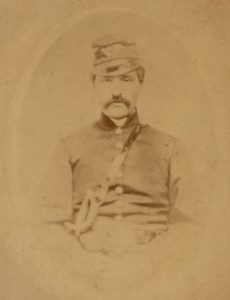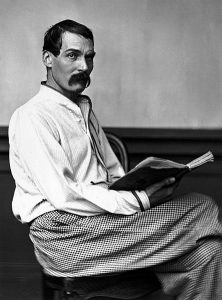Harry Heth Meets Richard Francis Burton
When I think of Confederate General Henry Heth, I can’t help but imagine actor Warren Burton’s portrayal of him in the 1993 film Gettysburg. I can just picture Heth now trying to explain to General Robert E. Lee (Martin Sheen) why he brought on an engagement at Gettysburg. I can clearly see the dissatisfaction on General Lee’s (Sheen’s) face. Regrettably, this is how Heth has been remembered.
While browsing Heth’s memoirs, I came across some fascinating accounts of his life before the American Civil War. One of these was a chance meeting with one of the Victorian era’s most famous explorers, Richard Francis Burton.

The Virginian graduated last in his class from the United States Military Academy in 1847 (just like his cousin, George E. Pickett). He goofed off most of the time with his pal and roommate, Ambrose E. Burnside. “I was not good,” Heth stated. “I was happy, and had a good time.” He piled up demerits, admitting, “My four year career at West Point as a student was abominable.”
Shortly after graduating from West Point, Lieutenant Heth sailed for Veracruz with four other green army officers. The U.S.-Mexican War had officially ended but he joined a company of the Sixth Infantry in garrison duty. He became messmates with Lieutenants Lewis A. Armistead and Winfield Scott Hancock and was reunited with Burnside. “Heth, old fellow, I want to caution you about having anything to do with these Mexican girls,” Burnside warned his friend, “they are she-devils, the most jealous beings on earth; when angry they would not hesitate to knife you, or to cut your throat.” But Burnside’s advice didn’t stop Heth, who acted as a wingman to Hancock while he chased after the local señoritas.
Heth remained in the army after the war and saw extensive service against Indians on the frontier. He took part in the Battle of Blue Water on September 3, 1855, when Colonel William S. Harney attacked and destroyed a Lakota village in Nebraska in revenge for the murder of Lt. John Lawrence Grattan and thirty of his men. In 1857, he was stationed in Utah under General Albert S. Johnston (followed by Lt. Colonel Charles F. Smith) at Camp Floyd, forty miles south of Salt Lake City. When Captain Richard Francis Burton arrived at Camp Floyd in September 1860, the thirty-five-year-old Heth offered Burton a spare bed in his quarters.
Burton was already an international celebrity when he arrived to the United States. He was a brilliant linguist, prolific author, and enthusiastically studied native customs. In 1853, the British army officer had disguised himself as a pilgrim and braved death to make the Hajj to Mecca. While searching for the source of the Nile in 1858, he discovered Lake Tanganyika in East Africa (and nearly died). He decided to visit the United States soon after.

Burton left England in April 1860. When he arrived to the United States, he met with Secretary of War John B. Floyd, who gave him letters of introduction so that he could travel to different frontier posts. He had a fascination for the Mormons and planned to write a book about them. Burton stayed liquored up during most of his travels and was obsessed with the desire to be ambushed by a party of Indians.
Burton got along wonderfully with Heth during the five days at Camp Floyd. “My host was a son of that Old Dominion of Queen Elizabeth,” Burton recalled, “where still linger traces of the glorious Cavalier and the noble feudal spirit, which (alas!) have almost disappeared from the mother country.” Burton was impressed with Heth’s ability to hunt buffalo with a bow (He also mastered killing them with a revolver). “I have met but one officer, Captain Heth, of the 10th Regiment, who ever [sic] acquired the art,” Burton declared.
Heth became a favorite source for answering Burton’s questions about Indians, Mormons, frontier life, animals and the geography. He took pages of notes that he later published in a book titled, The City of Saints, and Across the Rocky Mountains to California (1862). The book mentions Heth’s name in several instances. Heth apparently didn’t mind being interrogated or acting as chaperon to the Englishman, and found him to be “a most enjoyable companion.”
Burton picked Heth’s brain on the subject of scalping. He gained a reputation for covering taboo subjects in his other books. “He was anxious to secure some Indian trinkets, and especially an Indian scalp,” Heth wrote, “I happened to have what he wanted, and gave him my collection. He said he promised his sweetheart in England to bring her an Indian scalp.” It is doubtful that his fiancé at the time, Isabel Arundell, cared for a scalp. She instead considered entering the nunnery after Burton failed to inform her of his premature departure to the United States (she also had heard rumors that he had been killed during his trip).
Burton returned to England after his tour of the United States. Heth and Burton stayed in contact until the outbreak of the American Civil War. Their correspondence ended soon after and never resumed. Heth wrote his memoirs in 1897 (later published in 1974). The Memoirs of Henry Heth provide insight into Heth’s experiences and thoughts before the American Civil War—including his chance meeting with the famed British explorer—and it is essential reading for any student of the American Civil War. It helps to give us a comprehensive view of Heth, freeing him from the narrative of the hapless general who started the Battle of Gettysburg in search of shoes.
Bibliography
Burton, Richard F. The City of Saints, and Across the Rocky Mountains to California. New York: Harper & Brothers, Publishers, 1862.
Farwell, Byron. Burton: A Biography of Sir Richard Francis Burton. New York: Holt, Rinehart & Winston, 1963.
Heth, Henry. The Memoirs of Henry Heth, ed. James L. Morrison. Westport, CT: Greenwood Press, 1974.
Jordan, David M. Winfield Scott Hancock: A Soldier’s Life. Bloomington: Indiana University Press, 1988.
Great reading.
So good! We need to remember that these “great men” were, infact, just men who spent about four years of their entire lives fighting in the Civil War. There was much more to them.
Brother adventurers!!!
A part of me doesn’t really want to write this post because I enjoyed the Heth story and the additional insight I gained about him from Mr.Jastrzembski’s article. But unfortunately, one word jumped off the page at me in respect to the reference to the First Sioux War…that word being “murder”. The related backstory of the death of Lt. Grattan is typically sad in the context of that era’s conflict. A cow had strayed from the Oregon Trail and was killed by a Miniconjou tribal man by the name of High Forehead who was visiting the Sioux near Ft. Laramie. The Mormon owners of the cow complained to Lt. Grattan’s superior, Lt. Hugh Fleming. Fleming consulted with Sioux chief, Conquering Bear and the chief offered one of his horses or a cow from the tribes herd as restitution. Lt. Fleming was aware that this was not a military matter and was going to refer it to Indian agent John Whitfield who was expected to arrive within a few days with annuities which could also be used by the Indians for restitution if preferred by the cows owner who was demanding $25. Lt. Fleming asked the Sioux to arrest High Forehead and deliver him to the fort. Conquering Bear said he had no authority over a visitor and refused so as not to violate Sioux traditions of hospitality. Lt. Grattan, a recent graduate of West Point who was waiting for a vacancy in Fleming’s 6th US Infantry Regiment led an armed detachment of 28 soldiers, and a translator (apparently without orders) to attack the Indian encampment. In the battle Grattan and his entire unit perished.
In the interest of fairness I don’t see his loss and that of his men as “murder”. It was a pitched battle and the inexperienced and overzealous Lt., described as contemptuous of the Sioux tragically led his men into an armed camp. This was one of the earliest events of the Plains War and in this instance was provoked by the Army. The tragic outcome was not murder.
For the record the above description was gleaned from Wikipedia…where they chose to describe the battle as a massacre. It’s classic, if the Indians in defending an attack prevailed it was a “massacre”, if the Army had prevailed it would have been described as an honorable battle.
As historians, professional and amateur, we need to rise above this language and honor the brave fighters on both sides of this conflict.
Dale:
Well said. R. Eli Paul has written a solid book on Blue Water Creek and what led to it, including Grattan’s stupidity which ignited the conflict. If there was “murder”, it involved what Harney did.